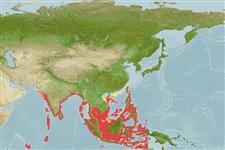Environment: milieu / climate zone / Tiefenbereich / distribution range
Ökologie
seewasser riff-verbunden; tiefenbereich 5 - 80 m (Ref. 9773). Tropical; 24°N - 12°S, 59°E - 133°E (Ref. 55)
Indian Ocean: Zanzibar, Seychelles and Madrakah, southern Oman; up to Sri Lanka, and India. Formerly confused with Lutjanus xanthopinnis known from the Indo-West Pacific region.
Size / Gewicht / Alter
Geschlechtsreife: Lm ? range ? - ? cm
Max length : 32.5 cm TL Männchen/unbestimmt; (Ref. 132370); common length : 20.0 cm TL Männchen/unbestimmt; (Ref. 55); max. veröff. Gewicht: 425.00 g (Ref. 132370)
Rückenflossenstacheln (insgesamt) : 10; Rückenflossenweichstrahlen (insgesamt) : 13; Afterflossenstacheln: 3; Afterflossenweichstrahlen: 9. This species is distinguished by the following characters: no scales on the preopercular flange; scales on the cheek 7-8 rows; with a rounded posterior nostril; predorsal scales extending to about the level of the posterior edge of the orbit; with a prominent mid-lateral yellow stripe, from 1.5 to 3 scale rows wide (Ref. 106991).
Cross section: compressed.
Adults inhabit coral and rocky reefs (Ref. 55) in coastal areas and outer slopes.
Life cycle and mating behavior
Geschlechtsreife | Fortpflanzung | Ablaichen | Eier | Fecundity | Larven
Iwatsuki, Y., F. Tanaka and G.R. Allen, 2015. Lutjanus xanthopinnis, a new species of snapper (Pisces: Lutjanidae) from the Indo-west Pacific, with a redescription of Lutjanus madras (Valenciennes 1831). J. Ocean Sci. Found. 17:22-42. (Ref. 106991)
IUCN Rote Liste Status (Ref. 130435: Version 2025-1)
Bedrohung für Menschen
Harmless
Nutzung durch Menschen
Fischereien: kommerziell
Tools
Zusatzinformationen
Download XML
Internet Quellen
Estimates based on models
Preferred temperature (Ref.
123201): 27.3 - 29.2, mean 28.6 °C (based on 1038 cells).
Phylogenetic diversity index (Ref.
82804): PD
50 = 0.5000 [Uniqueness, from 0.5 = low to 2.0 = high].
Bayesian length-weight: a=0.01479 (0.00706 - 0.03101), b=2.97 (2.80 - 3.14), in cm total length, based on LWR estimates for this Genus-body shape (Ref.
93245).
Trophic level (Ref.
69278): 4.0 ±0.66 se; based on food items.
Widerstandsfähigkeit (Ref.
120179): mittel, Verdopplung der Population dauert 1,4 - 4,4 Jahre. (Preliminary K or Fecundity.).
Fishing Vulnerability (Ref.
59153): Low vulnerability (23 of 100).
🛈
